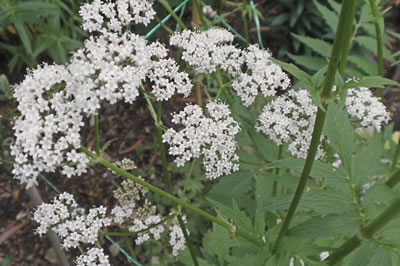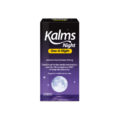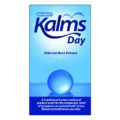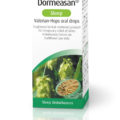Valerian
 Sometimes described as nature’s tranquilliser, valerian (Valeriana officinalis L.) grows wild in North America and Europe although it is also cultivated for medicinal purposes. The name valerian is thought to come from the Latin ‘valere’ meaning ‘to be well’.
Sometimes described as nature’s tranquilliser, valerian (Valeriana officinalis L.) grows wild in North America and Europe although it is also cultivated for medicinal purposes. The name valerian is thought to come from the Latin ‘valere’ meaning ‘to be well’.
The erect, fluted stems can grow as tall as 2m, with indented leaves forming a rosette around the base of the plant. Throughout summer it boasts umbrella-shaped clusters of pinkish flowers that grow from a tuberous rootstock or rhizome, which contains its active ingredients. These are harvested in autumn after the leaves have died back.
History of Use
Valerian was used as early as the fourth Century BC recommended by the Greek physician Hippocrates. Both the Greeks and the Romans used valerian medicinally mostly for digestive problems, nausea, liver complaints and urinary tract disorders. It has a distinctive, rather unpleasant smell and was aptly called ‘phu’ by the Greek physician Galen who was the first to write about valerian’s use as a treatment for insomnia.
In Medieval Europe valerian was credited with tranquilising properties that could cure or at least treat epilepsy. It was also used during this period as a remedy for stomach upsets and as an antidote to the plague.
 Since April 2014, all herbal medicines for sale in the UK and Europe must be approved by the Medicines & Healthcare Products Regulatory Agency (MHRA) having been rigorously checked for safety and quality. They must also display the Traditional Herbal Registration ‘THR’ logo on their pack.
Since April 2014, all herbal medicines for sale in the UK and Europe must be approved by the Medicines & Healthcare Products Regulatory Agency (MHRA) having been rigorously checked for safety and quality. They must also display the Traditional Herbal Registration ‘THR’ logo on their pack.
Use of valerian for insomnia and nervous conditions became more common in the 1500s and since the 1700s has been widely taken as a sedative, as a remedy for nervous disorders, trembling, headaches and heart palpitations.
The following products contain Valerian
Kalms Night One-a-Night
A traditional herbal medicinal product used for the temporary relief of sleep disturbances, based on long standing traditional use only. Read more
Kalms Day
Traditional herbal medicinal product used for the temporary relief of symptoms associated with stress such as mild anxiety based on traditional use only. Read more
Vitabiotics Valerian Tablets
Vitabiotics Valerian is a traditional herbal medicinal product used for the temporary relief of sleep disturbances and mild anxiety. Exclusively based upon long-standing use as a traditional remedy. Read more
Herbal Store Stress Relief Tablets
A traditional herbal remedy to aid relaxation from everyday stresses. Read more
Stress Relief Daytime Valerian-Hops Oral Drops
Stress Relief Daytime is a traditional herbal medicinal product used for the temporary relief of symptoms of stress and mild anxiety. Based on traditional use only. Read more
Kalms Night
A traditional herbal medicinal product used for the temporary relief of sleep disturbances, based on traditional use only. Read more
Herbal Store Sleep Aid
A traditional herbal remedy to promote a natural calming sleep. Read more
Dormeasan Sleep Valerian-Hops Oral Drops
Dormeasan Sleep is a traditional herbal medicinal product used for the temporary relief of sleep disturbances resulting from mild anxiety. Based on traditional use only. Read more
